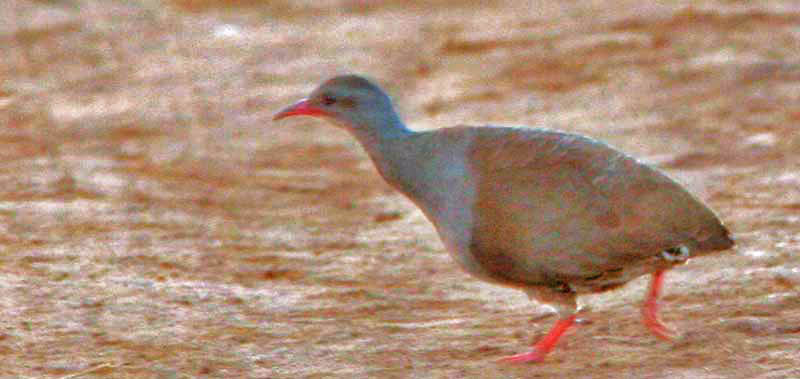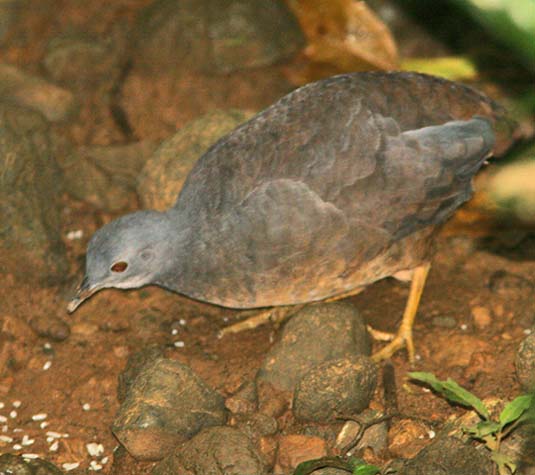
a web page by Don Roberson |
TINAMOUS Tinamidae |
|
Otherwise it takes much patience, quiet, and luck. I have generally found my tinamous when alone. Even the presence of one or two other people makes them harder to find, because a small group is invariably noisier than a lone tracker, no matter how much care is taken. There are still several tinamou species that I've only heard but have not seen, and thus they are not on my "life list." Tinamous occur in pairs or alone, but many species are very vocal. Some have sad whistles or organ-like notes. Their calls can be heard at dawn or dusk for long distances. There is a wonderful tape in the Hardy series of their vocalizations. |
Although outwardly a tinamou may resemble a tail-less quail or small grouse, they are actually related to the flightless ratites (rheas, ostrich, emu, etc.) and not to any of the "chickens" (I understand they are tasty, though, and heavily hunted by local peoples; the only Great Tinamou I've seen was freshly killed by a local hunter in Peru). This puts them right up at the front of any taxonomic listing of world birds. Tinamous are among the oldest families in the New World, with fossils dating back ten million years. Their close relationship to ratites has been confirmed through multiple analyses: molecular analysis, palate structure, calcite orientation in eggshells, ontogeny, musculature, metabolic physiology, and others (summarized in Cabot 1992). Tinamou eggs are particularly lovely, being highly glossed like porcelain and colored green, turquoise, purple, or wine red. |
In southern South America, and especially Argentina or Chile where I understand that there are species of tinamou in more open country. This is also true in the grasslands of southern Brazil. In Emas National Park, one driving or walking the red-dirt roads through the grasslands is likely to see at least one tinamou each day. Small-billed Tinamou (below) is perhaps most common — shown here dashing across such a road. |
 |
Some of the nothuras (five species in genus Nothura) are open-country species and reasonable common in the southern third of South America. Others, though, are declining. One of these is Lesser Nothura. According to Birdlife International, "rapid and extensive conversion of cerrado grasslands is presumably causing a rapid population reduction in this small tinamou. The population is now likely to be small and fragmented over a large range, and the species therefore qualifies as Vulnerable." The species taxonomy of tinamous is not the subject of much controversy. The lists in Clements (1991) and Cabot (1992) are the same (though slightly different arrangements), and nothing much has changed since then. Yet because most tinamous are hard to see, and because South American field guides have been lacking for many areas (although now that is changing), tinamous can be difficult to identify. I suspect that it takes some field experience to get it all right. I saw a smallish, dark, red-legged tinamou in the forest along the Javarí River of northeast Peru back in 1975 that I struggled to identify from Meyer de Schauensee (1970) then, and others since. I was just checking my notes today, and the portraits & text on the tinamous in Cabot (1992), and it still looks like the initial impression — Cinereous Tinamou Crypturellus cinereus — was correct. But here I am 25 years later and still a bit uncertain. . . . Tinamous are like that. |
Photos: The Undulated Tinamou Crypturellus undulatus was taken with a small flash at Explorer's Inn, Tambopata Nature Reserve, Peru, in June 1987. The Little Tinamou C. soui was at Rio Tigre Lodge, Osa Peninsula, Costa Rica, on 26 Dec 2007. The Small-billed Tinamou C. parvirostris was at Emas NP, Brazil, on 25 July 2010. Photos © Don Roberson; all rights reserved. Bibliographic note: There is no "family book" per se, but an excellent introduction to the family, with striking photos (although still mostly from Chile & Argentina!), is Cabot (1992). Literature cited:
|
 The Tinamous are a family of primitive, secretive Neotropical birds, most of which are restricted to tropical lowlands in South America. In all the places I've visited in Central and South America, it is a major coup to just get a decent glimpse of wild tinamou. Rarely have I ever pointed a camera at one, and this was my first successful result: an Undulated Tinamou (left) foraging at the edge of the lodge clearing at Explorer's Inn, southeastern Peru. It is the first tinamou I'd ever seen "out in the open;" all my experiences with other species have been quick views of birds running away or crossing a trail deep inside the dark forest interior. Undulated Tinamou is, in fact, a very common and widespread bird in the Amazon Basin as evidenced by its distinctive and easily learned three-note whistle that is given throughout the day and is heard in the background of many tapes of tropical birds. But seeing one is a challenge. With patience, a good imitator might whistle one in to a small party of very, very quiet birders, as Van Remsen once did for us in an extremely remote region of the Amazon Basin.
The Tinamous are a family of primitive, secretive Neotropical birds, most of which are restricted to tropical lowlands in South America. In all the places I've visited in Central and South America, it is a major coup to just get a decent glimpse of wild tinamou. Rarely have I ever pointed a camera at one, and this was my first successful result: an Undulated Tinamou (left) foraging at the edge of the lodge clearing at Explorer's Inn, southeastern Peru. It is the first tinamou I'd ever seen "out in the open;" all my experiences with other species have been quick views of birds running away or crossing a trail deep inside the dark forest interior. Undulated Tinamou is, in fact, a very common and widespread bird in the Amazon Basin as evidenced by its distinctive and easily learned three-note whistle that is given throughout the day and is heard in the background of many tapes of tropical birds. But seeing one is a challenge. With patience, a good imitator might whistle one in to a small party of very, very quiet birders, as Van Remsen once did for us in an extremely remote region of the Amazon Basin.  Tinamous are not necessarily shy per se, but being terrestrial dwellers they run to avoid predators (flight is unusual and short) and their habitat is generally thick, dark, and dense. I've only been to one other location where one came out to the edge of the forest. This Little Tinamou (right) was enticed by grains of rice adjacent to the kitchen at Rio Tigre Lodge on the Osa Peninsula, Costa Rica, to make an appearance. Even then, though, it required a small flash to obtain photos.
Tinamous are not necessarily shy per se, but being terrestrial dwellers they run to avoid predators (flight is unusual and short) and their habitat is generally thick, dark, and dense. I've only been to one other location where one came out to the edge of the forest. This Little Tinamou (right) was enticed by grains of rice adjacent to the kitchen at Rio Tigre Lodge on the Osa Peninsula, Costa Rica, to make an appearance. Even then, though, it required a small flash to obtain photos.